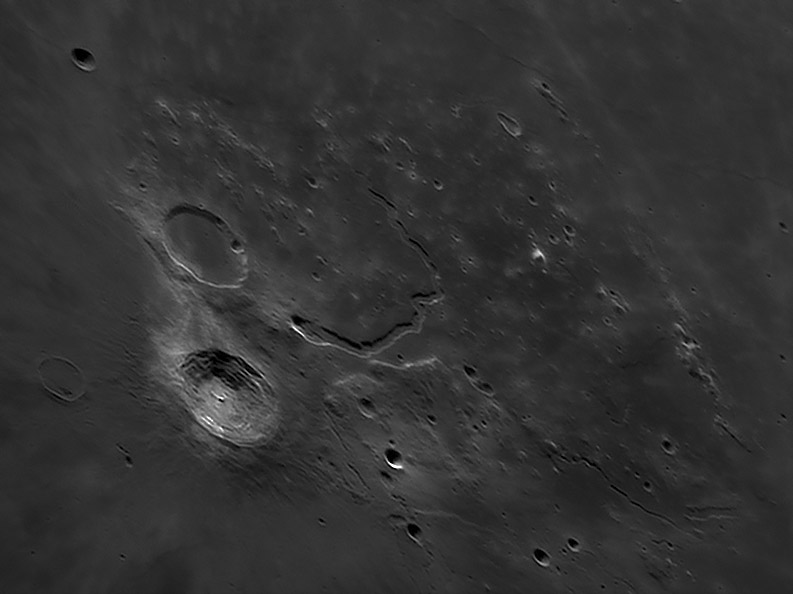Difference between revisions of "September 22, 2009"
| (3 intermediate revisions by the same user not shown) | |||
| Line 1: | Line 1: | ||
__NOTOC__ | __NOTOC__ | ||
=Catching Some Zzz= | =Catching Some Zzz= | ||
| + | <!-- Start of content --> | ||
<!-- ws:start:WikiTextHeadingRule:0:<h1> --> | <!-- ws:start:WikiTextHeadingRule:0:<h1> --> | ||
<!-- ws:start:WikiTextLocalImageRule:6:<img src="/file/view/LPOD-Sept22-09.jpg/90231339/LPOD-Sept22-09.jpg" alt="" title="" /> -->[[File:LPOD-Sept22-09.jpg|LPOD-Sept22-09.jpg]]<!-- ws:end:WikiTextLocalImageRule:6 --><br /> | <!-- ws:start:WikiTextLocalImageRule:6:<img src="/file/view/LPOD-Sept22-09.jpg/90231339/LPOD-Sept22-09.jpg" alt="" title="" /> -->[[File:LPOD-Sept22-09.jpg|LPOD-Sept22-09.jpg]]<!-- ws:end:WikiTextLocalImageRule:6 --><br /> | ||
<em>image by [mailto:bob_p@earthlink.net Bob Pilz]</em><br /> | <em>image by [mailto:bob_p@earthlink.net Bob Pilz]</em><br /> | ||
<br /> | <br /> | ||
| − | Look carefully at the inner walls of Aristarchus. Notice anything unusual? Not the bright spot on the near rim which is where a ray was deposited. Look at the opposite rim where a terrace near the top of the rim bends sharply down and about halfway down the rim turns up and stops. The terrace directly below it repeats the Z shape. Terraces don't do this. They are places where a large, fairly coherent mass of rim material slides downslope as a unit. Often terraces can be traced halfway or sometimes nearly all the way around the rim, showing that the whole annular block slid down at the same time - what a sight! The Zs show up in Alan Friedman's [ | + | Look carefully at the inner walls of Aristarchus. Notice anything unusual? Not the bright spot on the near rim which is where a ray was deposited. Look at the opposite rim where a terrace near the top of the rim bends sharply down and about halfway down the rim turns up and stops. The terrace directly below it repeats the Z shape. Terraces don't do this. They are places where a large, fairly coherent mass of rim material slides downslope as a unit. Often terraces can be traced halfway or sometimes nearly all the way around the rim, showing that the whole annular block slid down at the same time - what a sight! The Zs show up in Alan Friedman's [[November_12,_2007|shot]] has a high opposite lighting, clearly revealing the wall, but the Zs are not apparent. No better luck with Clementine, nor Apollo. Although it looks real I am beginning to think the Zs are a trick of lighting, rather than bending terraces. Who can come up with images to resolve this uncertainty?<br /> |
<br /> | <br /> | ||
<em>[mailto:tychocrater@yahoo.com Chuck Wood]</em><br /> | <em>[mailto:tychocrater@yahoo.com Chuck Wood]</em><br /> | ||
| Line 13: | Line 14: | ||
<br /> | <br /> | ||
<strong>Related Links</strong><br /> | <strong>Related Links</strong><br /> | ||
| − | Rükl plate [ | + | Rükl plate [https://the-moon.us/wiki/R%C3%BCkl_18 18]<br /> |
<br /> | <br /> | ||
<p><b>Yesterday's LPOD:</b> [[September 21, 2009|Peas in a Pod]] </p> | <p><b>Yesterday's LPOD:</b> [[September 21, 2009|Peas in a Pod]] </p> | ||
<p><b>Tomorrow's LPOD:</b> [[September 23, 2009|Crossing the Lines]] </p> | <p><b>Tomorrow's LPOD:</b> [[September 23, 2009|Crossing the Lines]] </p> | ||
<hr /> | <hr /> | ||
| + | {{wiki/ArticleFooter}} | ||
Latest revision as of 18:57, 13 October 2018
Catching Some Zzz

image by Bob Pilz
Look carefully at the inner walls of Aristarchus. Notice anything unusual? Not the bright spot on the near rim which is where a ray was deposited. Look at the opposite rim where a terrace near the top of the rim bends sharply down and about halfway down the rim turns up and stops. The terrace directly below it repeats the Z shape. Terraces don't do this. They are places where a large, fairly coherent mass of rim material slides downslope as a unit. Often terraces can be traced halfway or sometimes nearly all the way around the rim, showing that the whole annular block slid down at the same time - what a sight! The Zs show up in Alan Friedman's shot has a high opposite lighting, clearly revealing the wall, but the Zs are not apparent. No better luck with Clementine, nor Apollo. Although it looks real I am beginning to think the Zs are a trick of lighting, rather than bending terraces. Who can come up with images to resolve this uncertainty?
Chuck Wood
Technical Details
2009/09/13, UT: ~10:47. 200mm f/6 Newtonian, Televue 4X Barlow, DMK 21BF04 camera, Blue filter, 15 fps, Exposure 1/30 sec, 800/18000 frames. Processed by Registax V5, PS CS4, FocusMagic. Taken from Lat: 35 degrees 36 minutes N, Long: 82 degrees 33 minutes W, Elev: ~850m.
Related Links
Rükl plate 18
Yesterday's LPOD: Peas in a Pod
Tomorrow's LPOD: Crossing the Lines
COMMENTS?
Register, Log in, and join in the comments.



